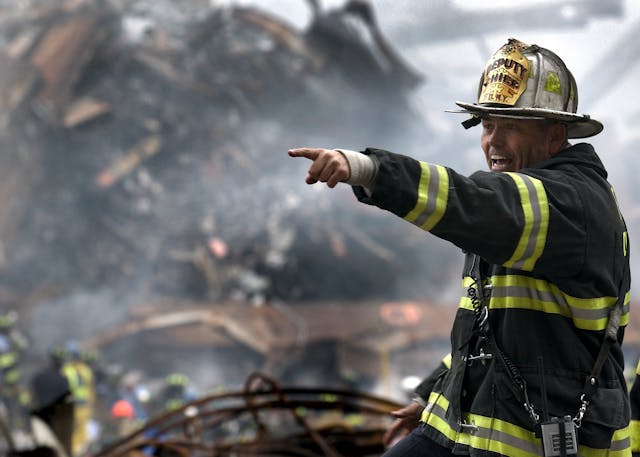In the United States, the landscape of firefighting is defined by a dedicated force comprising both career professionals and volunteers.
According to the National Fire Protection Association (NFPA), in 2020, there were approximately 1,041,200 firefighters across the nation. This diverse group is divided into 35% career firefighters and 65% volunteers. Notably, half of these firefighters fall within the age range of 30 to 49 years, representing a pivotal demographic in fire service roles.
Amidst this expansive landscape, continuous advancements in technology play a crucial role in enhancing the safety and operational efficiency of firefighters.
This article explores how innovative technologies are emerging as a game-changer for firefighters, mitigating the dangers they face.

Image via Pexels
1. Smart Personal Protective Equipment (PPE)
The traditional firefighter’s gear, while undeniably essential, often presents a trade-off between protection and mobility. Thankfully, advancements in technology are leading to the development of “smart” personal protective equipment (PPE).
These next-generation suits integrate a range of monitoring systems that can track a firefighter’s vital signs, including heart rate and respiration, in real time. This data can be relayed to commanders, providing crucial insights into a firefighter’s well-being during a blaze. Additionally, built-in gas detectors can alert firefighters to the presence of hazardous gases before they become a threat.
PR Newswire estimates the global smart PPE market to reach a staggering USD 7.61 billion by 2028, reflecting the growing demand for these life-saving technologies.
However, these advancements come with a cost. The integration of sensors and monitoring systems can make smart PPE more expensive than traditional gear.
Despite this challenge, the potential benefits for firefighter safety are undeniable. As the technology matures and costs become more manageable, smart PPE has the potential to become a standard in firefighting.
What are the PPEs used in firefighting?
PPE includes fire helmets, hoods & face protection, goggles, gloves, and boots. Each item is specialized to meet the demands of various firefighting tasks, offering options from breathable materials to insulated designs. Eye protection is just as important, especially in smoke-filled environments where visibility is limited. Many firefighters rely on wrap around prescription safety glasses to protect their eyes while maintaining clear vision in high-risk situations. This ensures optimal safety and comfort in diverse operational environments.
2. AFFF Concerns and Emerging Alternatives
Aqueous film-forming foam (AFFF) was once a staple in firefighting for its effectiveness in combating flammable liquid fires. However, it has come under scrutiny due to potential adverse health effects and environmental impact.
Concerns about AFFF stem from its chemical composition. It includes per- and polyfluoroalkyl substances (PFAS), known for their persistence in the environment and links to health issues like cancer.
These concerns have fueled a wave of lawsuits against the foam manufacturers filed across the nation. Lawyers estimate potential AFFF lawsuit settlement amounts to range from $40,000 to $300,000 or more depending on the case specifics.
TorHoerman Law notes that these projections highlight the complexity and severity of the issue. As litigation progresses, the outcomes will likely shape future regulations and industry practices toward safer firefighting foam alternatives.
This legal landscape underscores the urgent need for safer alternatives. Thankfully, research and development are actively exploring AFFF replacements. Some promising options include:
- Fluorine-free foams: These foams use alternative chemistries to achieve similar fire suppression capabilities without the potential health and environmental risks associated with AFFF.
- High-expansion foams: These water-based foams are more environmentally friendly and can be effective in specific fire scenarios.
The transition away from AFFF won’t be simple. Firefighters need training on using new foams effectively and ensuring their compatibility with existing equipment is crucial.
Is AFFF foam still used today?
AFFF foam is still used today but is being phased out. In December 2019, Congress mandated the removal of PFAS from military firefighting foams by 2024. The FAA also directed airports to switch to PFAS-free foams. However, the Navy continues using AFFF at sea until a suitable alternative is found.
What are the environmental impacts of firefighting foam?
Firefighting foam, particularly AFFF, contains PFAS chemicals, which are persistent in the environment and can contaminate soil and water sources. These chemicals pose risks to wildlife and human health, including potential links to cancer and other serious health issues. Efforts are underway to develop safer, eco-friendly alternatives.
3. Enhanced Situational Awareness
Navigating a burning building is a disorienting experience. Smoke fills the air, obscuring vision and hindering decision-making. However, a revolution in situational awareness technology is empowering firefighters to “see” through the smoke and operate more effectively.
Thermal Imaging Cameras (TICs) are already a firefighter’s lifeline, allowing them to detect heat signatures through smoke and darkness. According to Whidbey News-Times, the recent grant of $20,257 to North Whidbey Fire and Rescue highlights the critical role of TICs in modern firefighting.
These funds will support the acquisition of advanced thermal imaging cameras. This will empower firefighters to conduct rapid and effective searches in smoke-filled structures, thereby minimizing casualties and property damage. TICs aid in initial victim searches and facilitate ground searches for missing persons by detecting body heat signatures amidst complex environments.
The integration of TICs with other technologies further enhances their utility. It offers firefighters real-time data that improves decision-making and operational efficiency during emergencies. As these technologies evolve, they continue to redefine the capabilities and safety protocols of firefighting operations globally.
4. The Rise of the Robo-Firefighter
The image of a firefighter charging into a burning building is a symbol of courage. But what if technology could take on some of the inherent dangers, allowing firefighters to operate with greater safety and efficiency? Step into the world of firefighting robots.
These unmanned machines are transforming the way fires are fought. They can conduct reconnaissance, scout burning structures, and identify hotspots before humans enter.
Search and rescue operations become less perilous with robots locating victims through smoke and debris. Fire suppression efforts can be improved with robots wielding powerful water cannons or manipulating heavy equipment to create fire breaks.
According to Frontiers, the development of the Dragon Firefighter exemplifies this technological evolution. This flying firehose robot, an open-source project, aims to assist firefighters in combating the most perilous blazes.
Challenges such as extending its operational range beyond 10 meters remain. However, ongoing research and collaboration are expected to refine and optimize these robotic capabilities for broader deployment within the next decade.
5. Drone Technology
Firefighting is often a three-dimensional battle, with flames spreading across floors and rooftops. This is where drone technology is taking flight, offering a bird’s-eye view that revolutionizes how firefighters strategize and deploy resources.
Equipped with high-resolution cameras and thermal imaging, drones can provide real-time aerial footage of the fire scene. These visuals empower commanders with a crucial tactical advantage. They can pinpoint the fire’s origin and track its spread, allowing for better resource allocation and deployment of firefighters.
But drones aren’t just observers. They can be aerial assets. Drones carrying firefighting tools and water can be deployed to douse hard-to-reach blazes. This targeted approach can help contain flames and prevent further damage before ground crews arrive.
This article has explored the cutting-edge technologies transforming firefighting.
Further investment in research and development is essential to effectively integrate these technologies into firefighting practices.
Ultimately, the goal is a future where firefighters are equipped with the best tools to combat blazes and minimize risks. The transformative power of innovation can forge a future where fire is contained, rather than those who fight it.





